9
How can AI tools help produce engaging lesson plans and class meeting activities?
This chapter explores:
- how to prompt an AI tool to produce a draft lesson plan, and how to adapt it for classroom use;
- how to use AI tools to brainstorm classrooom activities.
Drafting Lesson Plans
The first steps in any writing task can be the most difficult and time consuming. AI tools can write a first draft of a lesson plan, which can be made classroom-ready through a combination of reprompting and human editing. Here is an example of a prompt for generating a lesson plan first draft:
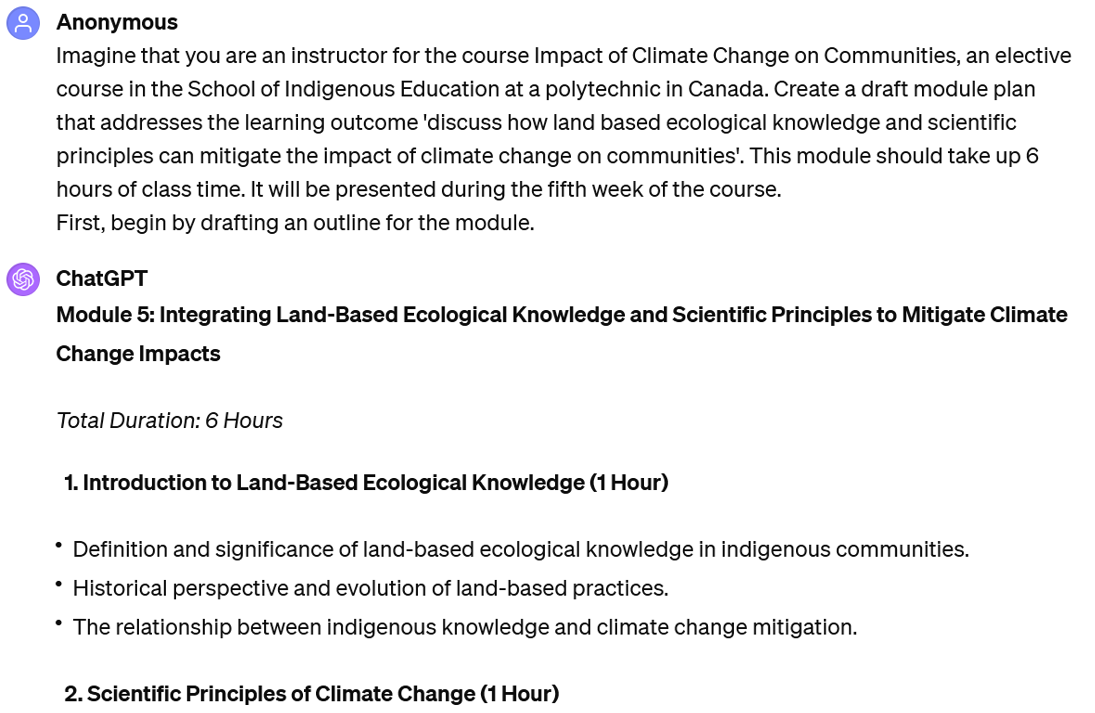
One RRC Polytech communication instructor, who used ChatGPT to generate a first-draft lesson plan about asking for clarification in a culinary workplace, found that the tool was useful for generating ideas and structure, but significant reworking was needed to make it useable for class.[1] Carefully editing and refining AI output is critical to ensure that the lesson plans produced are as good or better than the instructor could create without the use of AI tools.
Consider ChatGPT’s response to the prompt in the text box above. Some instructors may wish to start the class with an intro activity that raises student interest, turn the interactive lecture into a facilitated discovery activity, or have the guest speaker visit prior to the application activities. One or two rounds of reprompting followed by the instructor’s own revisions could turn that initial output into a usable lesson plan.
For those who plan to use an AI tool to produce multiple lesson plans, adding custom instructions could save time. One example of custom instructions might be “Every time I ask for a lesson plan, make sure that each hour of class time has a ten-minute break, no portion of an activity is longer than twenty minutes, and facilitative teaching and active learning strategies are employed whenever possible.” Uploading one or more previous lesson plans with a prompt could also improve the quality of the AI tool’s initial output. For more about reprompting, custom instructions, and adapting AI outputs, please see the Writing and Refining Prompts chapter.
In addition to speeding up lesson planning, AI tools can make lesson plans more effective. One RRC Polytech instructor found that it improved their scaffolding by ensuring that they didn’t overlook important foundational skills that students would need for completing a task.[2] When provided with information about what has already been covered in the course, AI tools can remind instructors to integrate review of previously taught concepts into lesson plans and make recommendations about how to draw connections between different course topics.[3]
AI tools can also provide suggestions for integrating multiple literacies into a lesson, such as incorporating digital or cultural literacy alongside a core topic,[4] and can be prompted to check or adapt a lesson plan according to a chosen framework or set of principles, such as Universal Design for Learning. AI tools can also review and critique an existing lesson plan, in general or according to chosen criteria such as accessibility, active learning, or connection to course learning outcomes.
Producing Classroom Activities
Once a lesson plan has been established, AI tools are able to brainstorm ideas for interactive classroom activities, accepting input about topic, audience, style, and other requirements. One RRC Polytech instructor teaching in an education-related program reported that AI tools allowed them to brainstorm activities in new formats when they had been using the same kinds of activities over and over.[5] See the following screenshot for an example of how to prompt an AI tool to generate classroom activity ideas, and click the image to read the full conversation (ChatGPT login required).
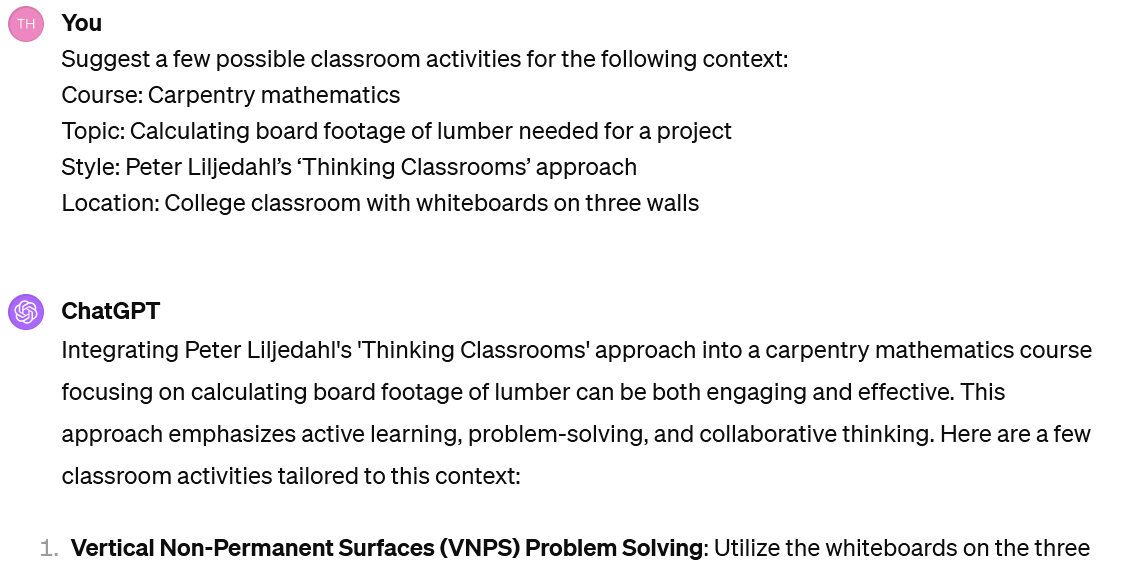
The above prompt generated eight suggestions, some of which could be directly usable or adaptable for the classroom. Once an activity is refined, AI tools can be prompted to produce a set of instructions for students, or instructions that a substitute instructor could follow.
In activity planning, the most common reported use of AI tools among RRC Polytech staff is creating or adapting a diverse set of examples, questions, or case study scenarios. The following section outlines more information about these topics.
Generating Examples
Mollick and Mollick note that providing students with a diverse range of examples leads to increased comprehension and recall, critical thinking, and ability to apply new information, and suggest weaving examples into lectures, practice questions, and course materials.[6] When teaching the same course in different programs, RRC Polytech communication instructor Jacob Carewick has used AI tools to rework an existing set of examples for a new context, noting that AI tools can incorporate jargon and workplace issues from specific industries.[7] Library and Academic Services Reference Technician Rosemary Woodby reported using AI tools to generate sample project topics for a research-related presentation to a civil engineering geomatics class.[8]
In addition to generating examples that make activities, lessons, and courses more relevant and engaging, AI tools can help vary a set of examples. This could include asking an AI tool to provide examples from varied perspectives, such as different organizational roles, generations, or backgrounds,[9] or to provide counterpoints.[10] Due to bias in AI tools’ training data, AI output need to be carefully reviewed to ensure that attempts to diversify content don’t perpetuate offensive stereotypes.
The following screenshot shows one way to prompt an AI tool for a list of examples. Click the image for ChatGPT’s response (login required).
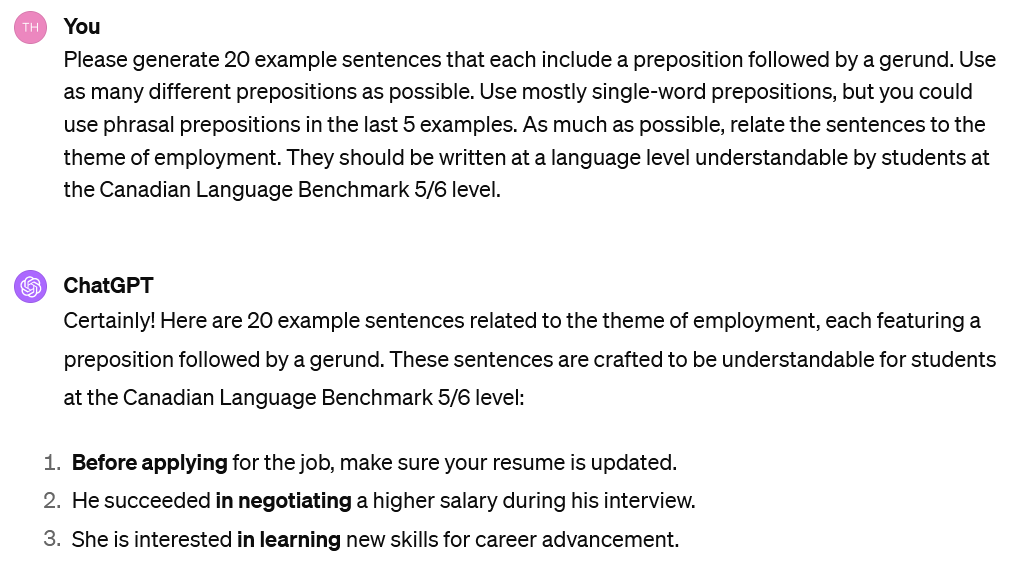
Generating Questions
AI tools can produce a large number of questions appropriate to a topic and level of knowledge. These might be questions for discussion, a review quiz, or in-class practice activities, and can be based on an AI tool’s existing information, a web search, or a supplied document. For example, Jacob Carewick and other RRC Polytech instructors have used ChatGPT while preparing for mock job interview activities, to produce technical questions outside their areas of expertise. [11]
See the following image for an example of how to prompt an AI tool to produce a set of questions.[12] Click the image for a ChatGPT’s full response and user reprompting to increase the level of difficulty (login required).
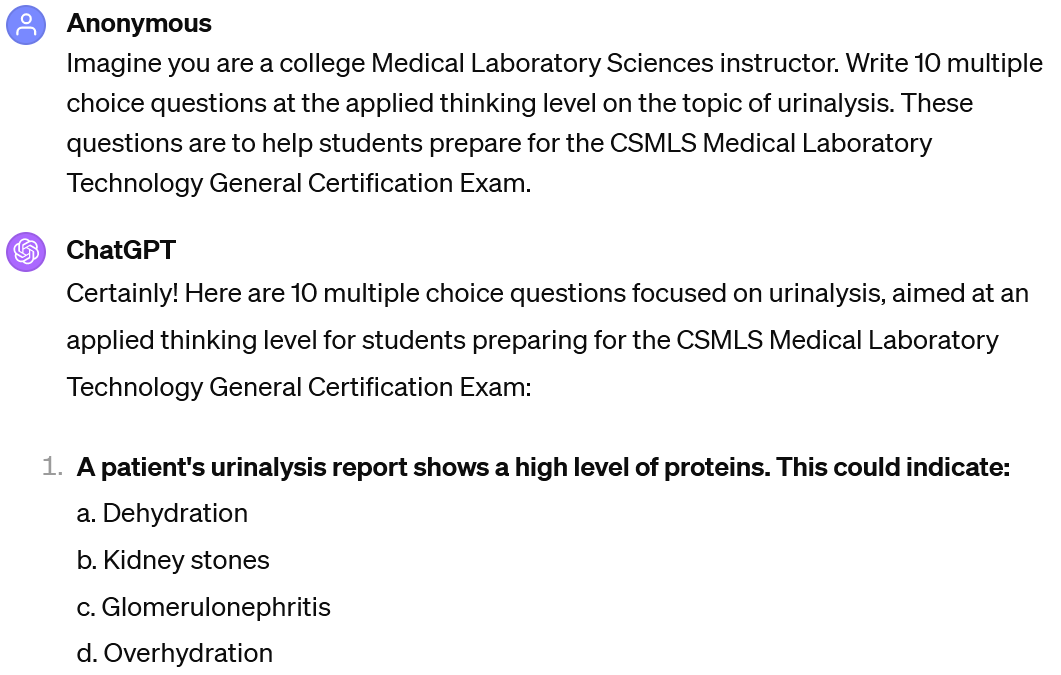
Generating Case Studies
AI prompts can also be the starting point for a range of case studies and scenarios. One RRC Polytech instructor has used ChatGPT to brainstorm ideas for communicative scenarios related to culinary employment, and has found them to be more closely connected to the cultural and social context of students’ future workplaces than scenarios they had drafted on their own. They engaged students in the process of revising the scenarios, increasing both the utility and relevance of the scenarios and students’ understanding of refining AI tool outputs.[13]
AI tools can create a list of potential scenarios or case studies based on a simple prompt. Including a few sample scenarios that have already worked in a course could improve the tool’s first output. Once an AI tool has generated a list of scenarios, one technique for follow-up prompting is to indicate which ones from the list work best and why, and to ask for more scenarios that are along the same lines.
The following image shows a sample prompt for generating case study scenarios.[14] Click the image to view the full interaction with ChatGPT, including follow-up prompts (login required).
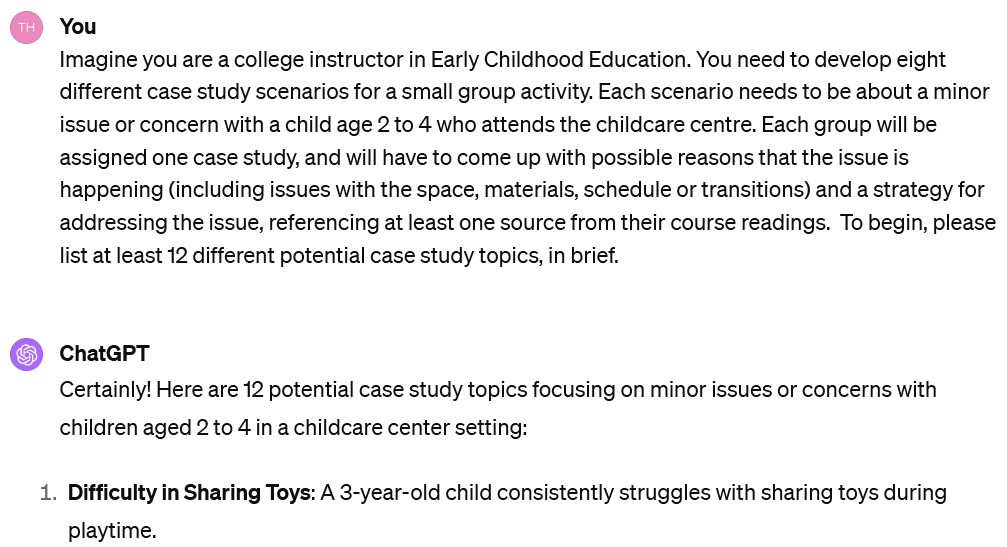
Key Takeaways
- AI tools can produce first drafts of lesson plans that can be adapted for use in class.
- AI tools can generate ideas and instructions for classroom activities.
- AI tools are useful for brainstorming examples, questions, and case studies.
Exercises
- Consider the lesson plan generated by ChatGPT earlier in this chapter. What changes need to be made to the lesson plan before delivering it? Would reprompting be an efficient way to refine the lesson plan, or should the instructor edit it themselves?
- Experiment with prompting an AI tool to generate case studies, examples, questions, and classroom activities related to your area of instruction. How would you rate the AI tool’s output? What prompting techniques yield the best results?
- Anonymous focus group participant, November 2023. ↵
- Anonymous focus group participant, November 2023. ↵
- Danny Liu, "Prompt Engineering for Educators—Making Generative AI Work for You," University of Sydney, last modified April 27, 2023, https://educational-innovation.sydney.edu.au/teaching@sydney/prompt-engineering-for-educators-making-generative-ai-work-for-you/. ↵
- CampGPT, "Open Prompt Book," Crowded Learning, last modified November 1, 2023, https://edtech.worlded.org/wp-content/uploads/2023/07/campgpt-prompt-book-2-compressed.pdf. ↵
- Anonymous focus group participant, November 2023. ↵
- Ethan Mollick and Lilach Mollick, "Using AI to Implement Effective Teaching Strategies in Classrooms: Five Strategies, Including Prompts," SSRN, last modified March 17, 2023, https://doi.org/10.2139/ssrn.4391243. ↵
- Jacob Carewick, focus group, November 6, 2023. ↵
- Rosemary Woodby, focus group, November 6, 2023. ↵
- Danny Liu, "Prompt Engineering for Educators—Making Generative AI Work for You," University of Sydney, last modified April 27, 2023, https://educational-innovation.sydney.edu.au/teaching@sydney/prompt-engineering-for-educators-making-generative-ai-work-for-you/. ↵
- Paul R. MacPherson Institute for Leadership, Innovation and Excellence in Teaching, "Generative Artificial Intelligence in Teaching and Learning at McMaster University," McMaster University, last modified 2023, https://ecampusontario.pressbooks.pub/mcmasterteachgenerativeai/. ↵
- Jacob Carewick, focus group, November 6, 2023. ↵
- Thank you to Michele Sykes, RRC Polytech Medical Laboratory Sciences instructor, for helping to create this example. ↵
- Anonymous focus group participant, November 2023. ↵
- Thank you to RRC Polytech Early Childhood Education instructor Monica Lytwyn for co-creating this example. ↵
A set of instructions that a user establishes with an AI tool, which apply to all of their interactions. Custom instructions can be set in ChatGPT by clicking on the user's name near the bottom left corner, then on Custom Instructions.

